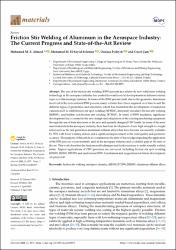| dc.contributor.author | Ahmed, Mohamed Mohamed Zaky | |
| dc.contributor.author | El-Sayed Seleman, Mohamed M. | |
| dc.contributor.author | Fydrych, Dariusz | |
| dc.contributor.author | Çam, Gürel | |
| dc.date.accessioned | 2023-12-26T10:30:54Z | |
| dc.date.available | 2023-12-26T10:30:54Z | |
| dc.date.issued | 2023 | en_US |
| dc.identifier.citation | Ahmed, M.M.Z., El-Sayed Seleman, M.M., Fydrych, D., Çam, G. (2023). Friction Stir Welding of Aluminum in the Aerospace Industry: The Current Progress and State-of-the-Art Review. Materials, 16 (8), art. no. 2971.
https://doi.org/10.3390/ma16082971 | en_US |
| dc.identifier.issn | 1996-1944 | |
| dc.identifier.uri | https://doi.org/10.3390/ma16082971 | |
| dc.identifier.uri | https://hdl.handle.net/20.500.12508/2810 | |
| dc.description.abstract | The use of the friction stir welding (FSW) process as a relatively new solid-state welding technology in the aerospace industry has pushed forward several developments in different related aspects of this strategic industry. In terms of the FSW process itself, due to the geometric limitations involved in the conventional FSW process, many variants have been required over time to suit the different types of geometries and structures, which has resulted in the development of numerous variants such as refill friction stir spot welding (RFSSW), stationary shoulder friction stir welding (SSFSW), and bobbin tool friction stir welding (BTFSW). In terms of FSW machines, significant development has occurred in the new design and adaptation of the existing machining equipment through the use of their structures or the new and specially designed FSW heads. In terms of the most used materials in the aerospace industry, there has been development of new high strength-to-weight ratios such as the 3rd generation aluminum-lithium alloys that have become successfully weldable by FSW with fewer welding defects and a significant improvement in the weld quality and geometric accuracy. The purpose of this article is to summarize the state of knowledge regarding the application of the FSW process to join materials used in the aerospace industry and to identify gaps in the state of the art. This work describes the fundamental techniques and tools necessary to make soundly welded joints. Typical applications of FSW processes are surveyed, including friction stir spot welding, RFSSW, SSFSW, BTFSW, and underwater FSW. Conclusions and suggestions for future development are proposed. | en_US |
| dc.language.iso | eng | en_US |
| dc.publisher | MDPI | en_US |
| dc.relation.isversionof | 10.3390/ma16082971 | en_US |
| dc.rights | info:eu-repo/semantics/openAccess | en_US |
| dc.subject | Aerospace industry | en_US |
| dc.subject | Aluminum–lithium alloys | en_US |
| dc.subject | BTFSW | en_US |
| dc.subject | Friction stir welding | en_US |
| dc.subject | RFSSW | en_US |
| dc.subject | SSFSW | en_US |
| dc.subject.classification | Aluminum | |
| dc.subject.classification | Bobbins | |
| dc.subject.classification | Welded Joints | |
| dc.subject.classification | Web of Science Core Collection - Science Citation Index Expanded | |
| dc.subject.classification | Engineering & Materials Science
- Metallurgical Engineering
- Friction Stir Welding | |
| dc.subject.other | Cu-li alloy | |
| dc.subject.other | Mechanical-properties | |
| dc.subject.other | Bobbin tool | |
| dc.subject.other | Microstructural evolution | |
| dc.subject.other | Butt-joints | |
| dc.subject.other | Tensile properties | |
| dc.subject.other | Residual-stress | |
| dc.subject.other | Strength | |
| dc.subject.other | Parameters | |
| dc.subject.other | Texture | |
| dc.subject.other | Aerospace industry | |
| dc.subject.other | Aluminum | |
| dc.subject.other | Aluminum alloys | |
| dc.subject.other | Friction | |
| dc.subject.other | Geometry | |
| dc.subject.other | High strength alloys | |
| dc.subject.other | Lithium | |
| dc.subject.other | Lithium alloys | |
| dc.subject.other | Research laboratories | |
| dc.subject.other | Spot welding | |
| dc.subject.other | Welds | |
| dc.subject.other | Aluminium-lithium alloys | |
| dc.subject.other | Aluminum lithium alloy | |
| dc.subject.other | Bobbin tool | |
| dc.subject.other | Bobbin tool friction stir welding | |
| dc.subject.other | Friction stir spot welding | |
| dc.subject.other | Friction-stir-welding | |
| dc.subject.other | Refill friction stir spot welding | |
| dc.subject.other | Stationary shoulder friction stir welding | |
| dc.title | Friction Stir Welding of Aluminum in the Aerospace Industry: The Current Progress and State-of-the-Art Review | en_US |
| dc.type | review | en_US |
| dc.relation.journal | Materials | en_US |
| dc.contributor.department | Mühendislik ve Doğa Bilimleri Fakültesi -- Makina Mühendisliği Bölümü | en_US |
| dc.identifier.volume | 16 | en_US |
| dc.identifier.issue | 8 | en_US |
| dc.relation.publicationcategory | Makale - Uluslararası Hakemli Dergi - Kurum Öğretim Elemanı | en_US |
| dc.contributor.isteauthor | Çam, Gürel | |
| dc.relation.index | Web of Science - Scopus - PubMed | en_US |
| dc.relation.index | Web of Science Core Collection - Science Citation Index Expanded | |
















